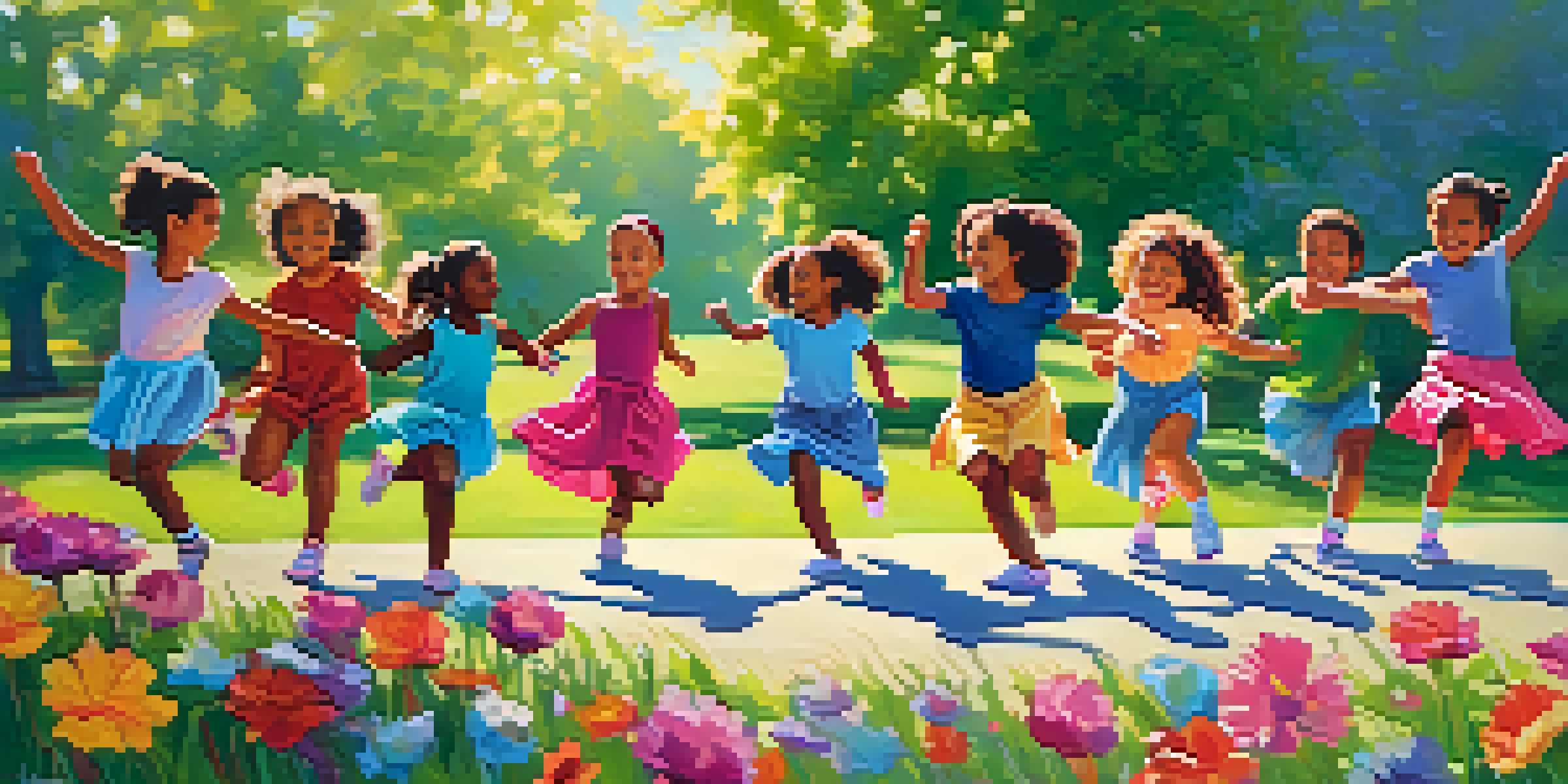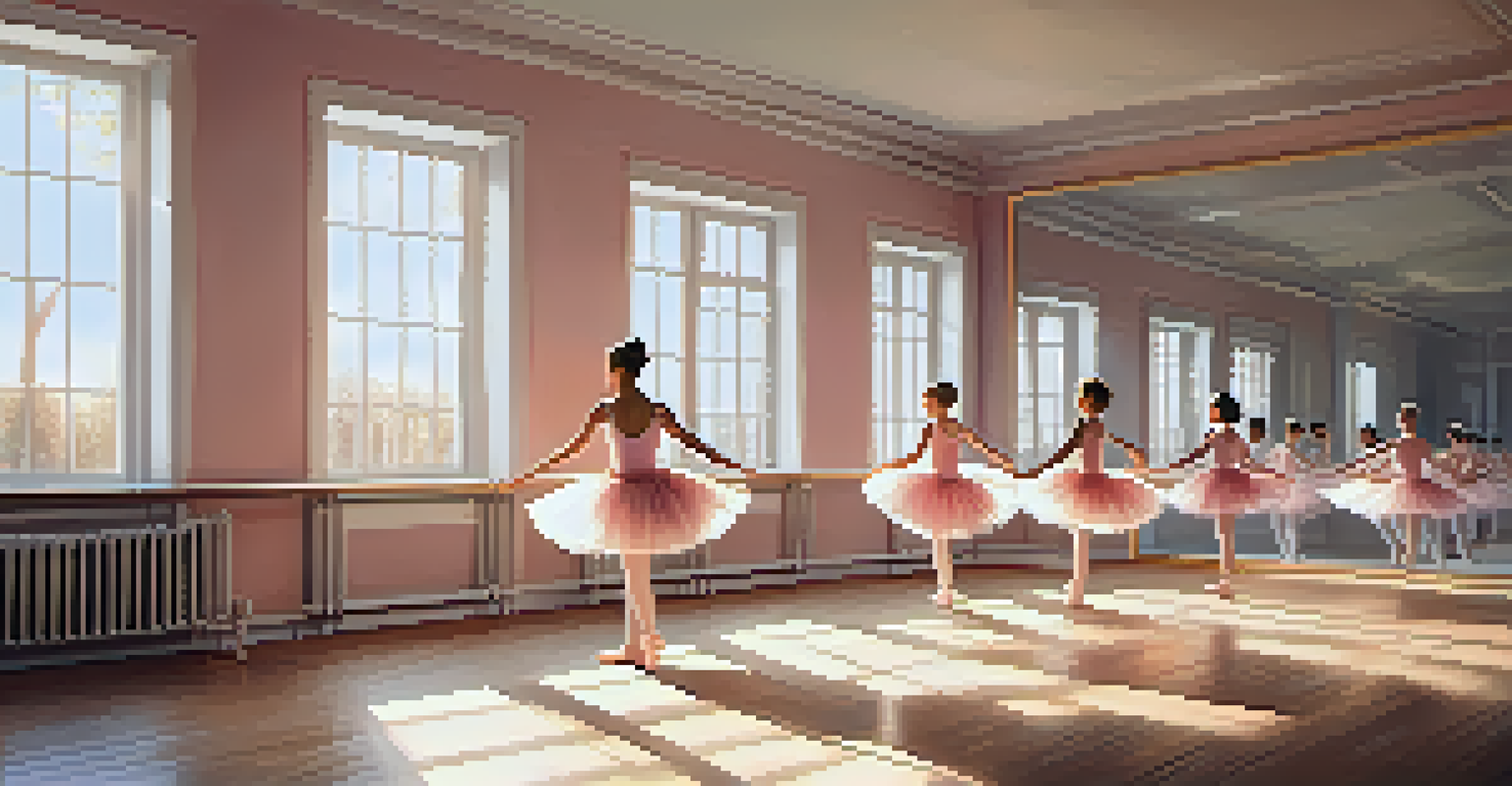Linking Dance Styles to Different Types of Child Play

Understanding the Connection Between Dance and Play
Dance and play are both essential for a child's development, fostering creativity and physical skills. Just as children express themselves through imaginative play, they also convey emotions and stories through dance. Recognizing the similarities between these two activities can enhance learning experiences, making them more enjoyable and effective.
Dance is the hidden language of the soul.
For instance, when a child engages in pretend play, they often embody different characters, much like a dancer takes on roles. This role-playing can mirror various dance styles, such as ballet's grace or hip-hop's energetic flair. By linking these forms of expression, we can better understand how children interact with their environment and each other.
Moreover, connecting dance styles to play types can help caregivers and educators create more dynamic learning environments. By incorporating dance elements into play activities, we can encourage children to explore their emotions and creativity in a safe and supportive space.
Ballet and Structured Play: A Perfect Match
Ballet, known for its structured movements and emphasis on technique, aligns perfectly with organized play activities. Children participating in structured play, such as team sports or guided games, benefit from the discipline and focus that ballet promotes. This connection between ballet and structured play fosters self-regulation and encourages children to follow rules and work collaboratively.

For example, a ballet class might involve practicing specific positions and routines, similar to how children learn to cooperate during a structured game. The grace and precision required in ballet can inspire children to develop their motor skills and coordination, which are essential for playing sports effectively.
Dance Enhances Child Development
Incorporating dance into play significantly contributes to children's physical, emotional, and social growth.
Additionally, integrating ballet-inspired movements into structured play can enhance physical literacy. By combining play with dance, children can build a strong foundation of movement skills while having fun, making both activities more engaging and enriching.
Hip-Hop and Unstructured Play: Freedom to Express
Hip-hop dance thrives on spontaneity and creativity, making it an ideal companion for unstructured play. In contrast to the rules of structured play, hip-hop encourages children to explore their movements freely, allowing for self-expression and individuality. This connection empowers kids to embrace their creativity and develop their unique dance styles.
Play is the highest form of research.
Consider a scenario where children engage in free play in a park, dancing spontaneously to music. This unstructured setting allows them to mimic hip-hop moves or create their own, fostering a sense of ownership over their bodies and movements. The freedom inherent in both hip-hop and unstructured play nurtures confidence and self-esteem.
Moreover, the rhythmic elements of hip-hop can enhance children's auditory skills, helping them develop a better sense of timing and coordination. By linking hip-hop dance with free play, we create opportunities for children to express their emotions and connect with their peers in a vibrant, energetic way.
Contemporary Dance and Cooperative Play: Teamwork in Motion
Contemporary dance is all about fluidity and expression, closely related to cooperative play that encourages teamwork and collaboration. In cooperative play scenarios, children learn to work together towards a common goal, such as building a fort or completing a group project. Similarly, contemporary dance often involves group choreography, requiring dancers to synchronize their movements harmoniously.
For instance, when children engage in cooperative play, they must communicate and negotiate with their peers, just as dancers do during a performance. This interplay fosters essential social skills like empathy and cooperation, which are vital for both dance and play. By encouraging both activities, we help children develop strong interpersonal skills.
Different Dances for Different Plays
Various dance styles, like ballet and hip-hop, complement specific types of play, enriching children's learning experiences.
Moreover, incorporating contemporary dance elements into cooperative play can enhance creativity and problem-solving skills. As children experiment with movements and work together to create a dance sequence, they learn to think critically and adapt to their peers, making both play and dance richer experiences.
Tap Dance and Rhythmic Play: A Beat for Learning
Tap dance, characterized by its rhythmic footwork, resonates well with rhythmic play activities. When children engage in play involving music or rhythm, such as clapping games or drumming circles, they naturally develop their sense of timing and coordination. This connection highlights the importance of rhythm in both tap dance and playful learning.
Imagine a group of children participating in a rhythm-based game where they must follow a beat. Their movements can mimic tap dance steps, reinforcing the idea that play can be a dynamic learning experience. The joy of rhythm can create a sense of community and shared purpose among children, enhancing their social interactions.
Additionally, linking tap dance to rhythmic play can cultivate a love for music and movement. By encouraging children to explore various beats and sounds, we help them develop a deeper appreciation for the arts while having fun, ultimately contributing to their overall growth and development.
Cultural Dance and Role-Playing: Connecting to Heritage
Cultural dance forms often embody the stories and traditions of a community, making them ideal for role-playing activities. When children engage in role-play that reflects their cultural heritage, they can connect with their roots while exploring their identities. This relationship between cultural dance and role-playing fosters a sense of belonging and pride.
For example, children might learn traditional dances from their families and incorporate those movements into their imaginative play. This practice allows them to express their cultural identities and share their heritage with others, promoting inclusivity and understanding. Such connections can enhance children's appreciation for diversity and encourage them to learn about different cultures.
Cultural Connection Through Dance
Cultural dance forms promote role-playing, helping children connect with their heritage and fostering inclusivity.
Moreover, integrating cultural dance into role-playing activities can spark curiosity and creativity. By exploring various cultural expressions, children can develop empathy and respect for others, enriching their social experiences both in play and in life.
The Role of Dance in Enhancing Child Development
Incorporating dance into children's play is not just about having fun; it significantly contributes to their overall development. Dance encourages physical fitness, coordination, and balance, while play fosters creativity and problem-solving skills. Together, these activities create a comprehensive approach to learning that benefits children in multiple ways.
Studies have shown that children who engage in dance and play exhibit improved emotional regulation and social skills. The combination of movement and expression allows them to navigate their feelings and connect with peers in a meaningful way. This holistic development is crucial for their future success both academically and socially.

By recognizing the importance of linking dance styles to different types of play, we can create enriching experiences that nurture children's growth. Whether through structured, unstructured, cooperative, or rhythmic play, integrating dance can enhance their learning journey and inspire a lifelong love for movement.
Conclusion: Embracing Dance and Play for Growth
In conclusion, the connection between dance styles and types of child play offers a wealth of opportunities for learning and growth. By understanding how these activities complement each other, caregivers and educators can create environments that foster creativity, collaboration, and self-expression. Embracing this synergy can lead to richer experiences for children, both in play and in dance.
Encouraging children to explore different dance styles through play not only enhances their physical skills but also nurtures their emotional and social development. As they move and create, they build confidence and resilience, essential traits for navigating the world around them. This holistic approach to learning can have lasting impacts on their lives.
Ultimately, by linking dance with play, we empower our children to embrace their creativity and individuality. Let's celebrate this vibrant connection, ensuring our kids have the tools they need to grow, thrive, and express themselves fully through movement and imagination.